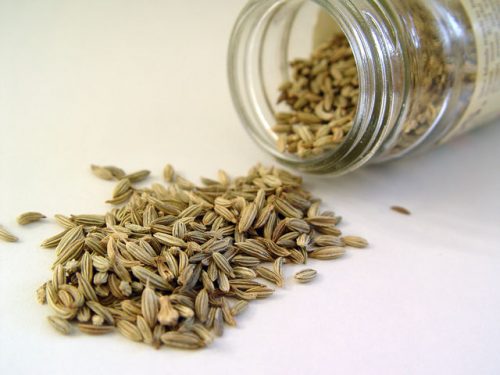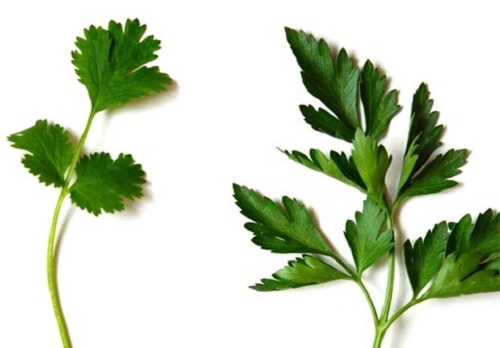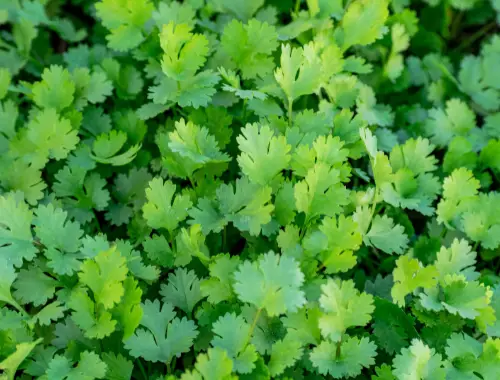
There is a plethora of spices to choose from when creating a culinary dish, some of which are more similar to one another than not. Two spices that sometimes get confused with one another are cumin and fennel. However, there are differences between these two.
-
Description
Cumin is a dried seed that comes from the parsley family. A cumin plant is approximately 30-50 centimeters tall and must be harvested by hand. It is an annual herbaceous plant, with a slender stem that has a diameter of approximately 8 to 12 centimeters thick. One each branch there are two to three sub-branches, leaving the plant with a uniform appearance. The stem is usually grey or dark green with long leaves with threadlike leaflets. Cumin flowers are small and can be white or pink. They come in bunches. The seeds have eight ridges with oil canals. They closely resemble caraway seeds in that they are long and oval in shape and have a yellow-brown color.[i]
Fennel is a flowering plant species that comes from the carrot family and is indigenous to the Mediterranean area, though it is now grown in many other parts of the world. It is a hardy herb with flowers and feathery leaves. Its average height is approximately 250 centimeters tall, making it much taller than a cumin plant. The leaves are also long and threadlike and the fruit is a dry seed about 4-10 millimeters wide.[ii]
-
In cuisine
Cumin seeds are ground and used as a spice. It has a distinct flavor and aroma, and it is most commonly used in foods from South Asia, Northern Africa, Brazil, and Latin America. It can be added to certain types of cheeses or breads and it is also an ingredient in many different spice blends, including chili powder, adobos, sofrito, garam masala, curry powder, bahaarat and dhana jeera. It is only the seeds from the cumin plant that are used as an edible ingredient.[iii]
Fennel is used in a much broader way in cuisine. It’s bulb, leaves, and seeds are all used in different dishes around the world. The most potent ingredient are the small flowers found on wild fennel. These can also be quite expensive. After they are picked, the seeds may change from brown or green to a dull grey. Fennel seed is an aromatic, anise-flavored spice and when cooking, it is best to use fresh fennel seeds if possible. In addition to cumin, fennel seeds can be confused with anise, though anise seeds are smaller. Fennel seeds are commonly used in Indian, Afghani, Iranian and other Middle Eastern cuisines. It is most heavily used in Kashmiri Pandit and Gujarati cooking, but is also used as an ingredient in some blends, including panch phoron and Chinese five-spice. Fennel seeds are also a key ingredient in Italian sausage. Dried fennel seeds can also be used as a breath freshener (it is often an ingredient in toothpaste) or an after-meal digestive aid. Fennel seeds can also be turned into a candy called comfit.[iv]

In addition to the seeds, other parts of fennel are also used in various dishes. The leaves are used in India as a leafy, green vegetable that is served either alone or with other vegetables. In Syria and Lebanon, these leaves are added to an omelet called ijjeh and in other areas, it is an ingredient in risotto. Dried leaves are often used to enhance the flavor of many egg, fish or other dishes, and Florence fennel leaves are used in Italian and German salads. The fennel bulb is a crisp vegetable that can be eaten raw, sautéed, stewed, and grilled. It is also commonly used as a salad ingredient.[v]
-
Cultivation and Production
Cumin is primarily grown and produced in India. They produce 70% of the world supply. Domestically, they also consume 63% of the world supply, exporting the remainder. Other countries that produce cumin include Syria, Iran and Turkey. Cumin is a tropical or sub-tropical plant that usually grows best in a Mediterranean climate, or when the temperature range is between 25 and 30 degrees Celsius. It is very vulnerable to frost damage and grows well in loamy soils with high oxygen levels. It is also sensitive to salinity. It is a drought-resistant plant that uses much less water than other plants.[vi]
Like cumin, fennel also originated in the Mediterranean area and still grows well in this climate type.[vii] In present day, it is widely grown around the world, with India being the top producer. Other large producers are Mexico, China, Iran and Syria. It can grow well in certain areas of North America and the United States and Canada are in the top ten producers. It has become naturalized in many areas, even becoming an invasive species in Australia and the United States.[viii]
-
Classification
Cumin and fennel also have quite different scientific classification. They are both members of the kingdom Planta and the order Apiales. They also belong to the same family, Apiaceae, although fennel belongs to the subfamily Umbelliferae. This is where they diverge. Cumin is in the Cuminum Genus and the species is cyminum. Fennel belongs to the genus Foeniculum and the genus vulcare.[ix]
-
Nutrition
The two herbs also provide different nutrients. Cumin is a very good source of iron and the secondary metabolites present in it are cuminaldehyde, cymene, and terpenoids. Fennel seeds typically provide less vitamin content, but they are very high in dietary fiber and minurals. Foeniculoside I is the secondary metabolite present in fennel.[x]












Leave a Reply